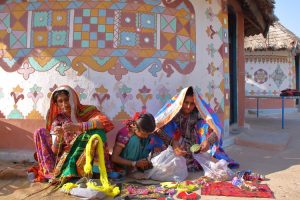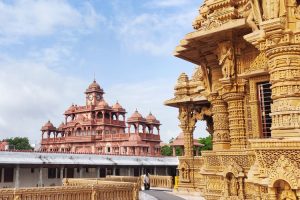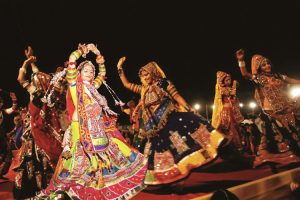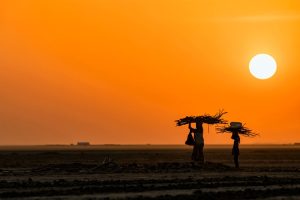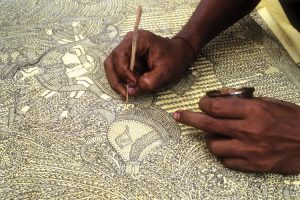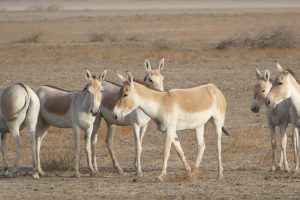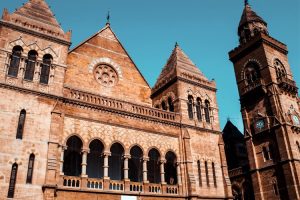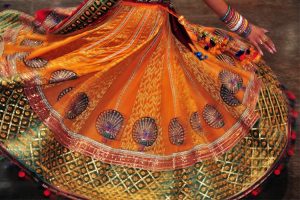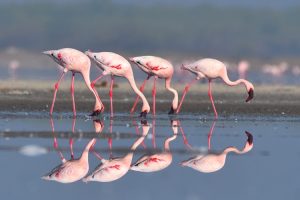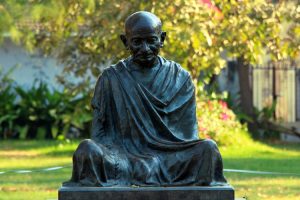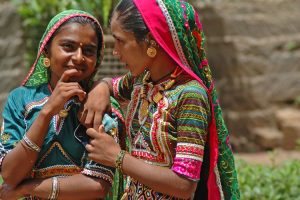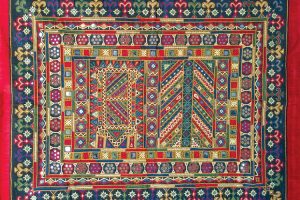India, Northwest India | Tours
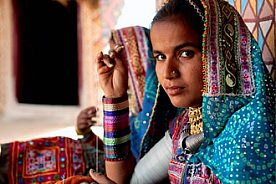
- Duration: 17 days from the UK
- Private Departures Available
Flight inclusive from £5930, Land only from £4995
Explore India at its most flamboyant in the company of renowned textile artist, Sue Lawty.
Highlights
- Enjoy a unique, specialist tour in the company of Sue Lawty, one of Britain’s foremost artists
- Experience first-hand all aspects of the rich Gujarat and Kutch textile culture
- Visit the picturesque villages of the Banni Grasslands and meet local craftsmen and women
- See some of the fine palaces and temples of this vibrant region
- Take a jeep safari to explore the Little Rann of Kutch
- Take a heritage walk around Ahmedabad and spend a day at a local fair
Gujarat in western India is renowned for its dazzling textiles and fine handicrafts. The many different styles, from mirror work to fine embroidery, are each connected to the traditions of a particular community or ethnic group and go back generations.
Led by acclaimed artist Sue Lawty you will explore Gujarat’s rich architectural, artistic and cultural heritage, visiting a number of key textile centres along the way including Ahmedabad, Gondal, Jetpur, Junagarh, Banni, Bhuj, Kutch, Dasada and Patan. From village markets and local museums which have an incredible array of fabrics and textiles on display, to craft workshops with hands-on demonstrations of age-old techniques such as wood block printing, tie-dye manufacture, and weaving, you will gain an insight into the role that textiles have played in Gujarat over the centuries.
The tour starts in Ahmedabad, famous for its connection with Mahatma Gandhi, where you will visit a local market, the Calico Museum and and several cultural sights. Travelling on to Gondal you visit the the Navlakha Palace with its fine collection of crafts and learn about the textiles of this area. Moving on to the desert town of Bhuj, you will have seven days to explore its many fascinating attractions including local markets and palaces, as well as travelling out to beautiful Banni villages with their fine artistic heritage, and to Mandvi on the coast and centre for traditional boat building and mashroo weaving. You will also spend a day at the Mekan Dada fair in Dhrang where rural traditions are celebrated.
A real highlight of the tour is an early morning jeep safari across the Little Rann (desert) of Kutch in search of rare Asiatic wild asses and other birds and wildlife. And for a final fabulous flourish you visit the master craftsmen of Patan Patola, who create the most magnificent Double-Ikat silk textiles. On your return to Ahmedabad, you will enjoy a guided heritage walk and end your trip with a farewell dinner at a rooftop restaurant.
Private Departures
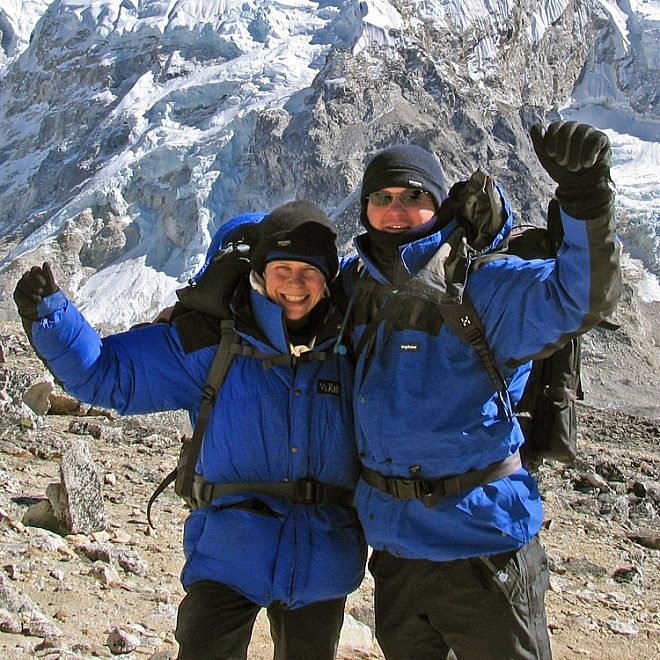
Colours of India - Gujarat Textiles - Private Departures
If you would prefer to travel just with your partner, friends or family, we can arrange a private departure of this holiday. You follow the same itinerary, but travel on dates that suit you. Alternatively we can include elements of this holiday in a bespoke Tailor Made itinerary. Contact our friendly team for details and prices, and to make a booking.
At a glance
Duration: 17 days from the UK
Private Departures Available
Guaranteed to run for a minimum of 4 clients
Maximum group size: 12
Accommodation types: Hotels
Festival:
This holiday attends the Mekan Dada fair in Dhrang
Meal arrangements: All meals are included.
Itinerary overview
| Day | Activity |
|---|---|
| 1-2 | Overnight flight to Ahmedabad. Visit Law Garden Market. |
| 3-4 | Sightseeing in and around Ahmedabad including the Calico Museum and Pethapur craft village. Drive to Gondal. |
| 5 | Visit the Khadi centre, Jetpur village, Navlakha Palace, local market and Swaminarayan Temple in Gondal. |
| 6 | Drive to Bhuj via salt marsh. Visit LLDC Shrujan Museum. |
| 7 | Sightseeing in Bhuj plus visits to a bandhani workshop and museum quality textiles shop. |
| 8 | Visits to craft workshops and traditional Bhuj villages. |
| 9 | Hands on block printing workshop. Drive to Khamir. Visit village of Bhujodi. |
| 10-11 | Excursion to see mashroo weaving in south Kutch and wooden ship building at Mandvi with time at beach. Drive to visit Banni villages and Great Rann of Kutch salt flats. |
| 12 | Attend the Mekan Dada fair in Dhrang. |
| 13 | Drive to Rann Riders in Dasada with stop at Dhaneti village. |
| 14 | Jeep safari across Little Rann. At leisure. |
| 15 | Drive to Ahmedabad with visits en route to the Sun Temple at Modhera, Patan Patola Museum and the Rani Ki Vav step well. |
| 16 | Heritage walk of Ahmedabad with visit to Mata Ni Pachedi workshop and Sabarmati Ashram. Farewell dinner. |
| 17 | Group transfer to Ahmedabad Airport for overnight flight to London. |
Leader: Sue Lawty - Artist
Sue is one of Britain’s finest artists. Alongside other mediums, Sue has worked with textiles all her life and has exhibited extensively across the world. She is a tutor and visiting lecturer and has travelled on ‘weaving journeys’ to Bhutan, Morocco, America, Australia, India, Nepal and Poland
Sue held a year long Residency at the V&A in London and has been awarded prestigious Artist Research Fellowships at both the Smithsonian National Museum of Natural History, Washington DC and the Faculty of the Environment, University of Leeds. She was recently invited to take up a significant three month international artist residency in Stockholm.
Sue is an accomplished fell runner and mountain trekker and has led many successful trips for Mountain Kingdoms since she led our first Weavers’ Trail in Bhutan in 1995, later also leading treks to Dolpo and Zanskar. More recently, in 2019, she returned to Bhutan to lead our specialist Weavers’ Trail walking holiday and in 2022 and 2023 led the first departures of Colours of India.

Holiday Itinerary
Day 1 - Fly London to Ahmedabad
Depart London on your overnight flight to Ahmedabad in Gujarat.

Day 2 - Arrive Ahmedabad. Visit Law Garden Market.
You will land at Ahmedabad around 3.00am and be transferred to your boutique heritage hotel where rooms will be ready for you. Here you will have plenty of time to rest after your long flight. Your hotel has a pool if you fancy a refreshing dip!
Ahmedabad, the city of Ahmed Shah (the medieval ruler of Gujarat), is known for its rich past as well as its association with Mahatma Gandhi. The city features a unique style of architecture, which is a blend of Hindu and Islamic styles - the Indo-Saracenic style of architecture. The monuments of Ahmedabad mainly date back to the 15th century. Ahmedabad has been known for its industry since medieval times and is famous for its textile mills - in the past it was referred to as the 'Manchester of the East'.
Later in the day you will be driven to the Law Gardens (one of the best-known gardens of Ahmedabad) for a visit to the famous and colourful Law Garden Evening Market. The bustling street market is renowned for its traditional textiles; wall hangings, bandhej sarees, chaniyas (long colourful skirts), as well as other handicrafts such as antique jewellery and items made from cane and wood.
For dinner tonight you will have a traditional Gujarati meal at the award winning rooftop terrace restaurant at your hotel.

Day 3 - Morning visit to Jamalpur flower market, Sarkhej K Roza Necropolis, and Kalamkhush paper factory. Afternoon visit to the craft village of Pethapur..
Your day begins with a vist to the famous Jamalpur flower market with its extensive displays of fresh flowers - lilies, lotus flowers, roses and marigolds - often concocted into garlands for weddings or temple displays.
You will then visit Sarkhej Roza - an ancient royal necropolis just a few miles outside of Ahmedabad in the village of Markarba. Dating back to the 15th century it comprises many elegant monuments and tombs surrounding a large lake, or tank. Although timeworn in places there is still much intricate sandstone and marble carving to appreciate especially when the light falls through the beautiful carved screens, or jalis, producing beautiful patterns on the stone floors.
Returning to Ahmedabad you spend time at the Kalamkhush Handmade Paper Centre. In Hindi the words ‘Kalam’ and ‘Khush’ translate to pen and happy. Mahatma Gandhi introduced papermaking as a part of the Gandhi Ashram’s activities - it turned into a discrete handmade paper manufacturing unit in 1956. As you wander freely through this eco factory you will see close hand all the fascinating processes of production where waste cotton scraps are made into pulp which in turn is made into sheets of paper. A small shop sells the beautiful papers and paper products.
Lunch will be at Mirch Masala, a local Bollywood themed restaurant in the city, and then in the afternoon you drive for approximately 45 minutes to visit the craft village of Pethapur in Gandhinagar. The village is known for its beautiful saris and is a hub for wood block makers. These wooden blocks are carved with elegant patterns and then used for hand-printing on cloth. The villagers of Pethapur having been supplying customized wood blocks to centres of block printing all over India (and now worldwide) for at least 200 years.

Day 4 - Visit the Calico Museum of Textiles. Drive to Gondal - 260km/162 miles, 5 hours.
This morning you will visit the Calico Museum of Textiles, India's premier textile museum. This museum contains one of the world's finest collections of antique Indian textiles, all handmade and many up to 500 years old, with hundreds of beautiful pieces displaying incredible virtuosity and opulence. Here you learn about the history of textiles in Gujarat and how Ahmedabad emerged as a textile hub. The museum is housed in two buildings, one displaying textiles of religious significance and the other traditional court fabrics, tents, carpets and costumes. You will stop for lunch at a local restaurant and then drive to Gondal, a city to the southwest of Ahmedabad which has several interesting palaces. The city was once the capital of a princely state and during this time Gondal was ruled by a family of car enthusiasts whose royal passion resulted in a fine collection of automobiles which are now part of a museum in the palace premises. It was this royal passion that it led to Gondal having the best planned road system in pre-independence Gujarat.

Day 5 - Visit the Khadi centre in Gondal and see screen printing in Jetpur. Tour the Navalkha Palace and visit the local market and the Swaminarayan Temple in Gondal.
This morning you will visit the Khadi centre in Gondal. Khadi is a hand-spun and handwoven fabric made from locally grown cotton. You will then drive to Jetpur, a textile town renowned as one of India's largest centres for block printing, screen printing and dyeing. It is famous for printed cotton saree production and the town is a major exporter of khanga and kitenge. You will visit a screen printing factory and watch at close quarters all the hand processes which go into creating a saree length. The speed and accuracy is astonishing! After lunch at your hotel you take a tour of the Navlakha Palace, the former palace of the maharajas of Gondal, now converted to a museum. Also known as the Darbargadh, the name Navlakha evidently refers to the cost of this seventeenth century structure, which reputedly cost nine lakhs rupees - a lakh being 100,000 rupees. The palace has fine stone carvings with jharokhas (enclosed balconies), a pillared courtyard, delicately carved arches, and a unique spiral staircase. The large chandelier-lit durbar (court) contains stuffed panthers, gilt wooden furniture, and antique mirrors. From the palace you will head to the local vegetable and spice market – alive with noise and heady aromas. Your final stop of the day is the beautiful Swaminarayan Temple, which you will see in its full glory at sunset.

Day 6 - Drive to Bhuj - 270km/157 miles, approximately 6 hours. Pass the salt flats en route. Visit the Shrujan Museum.
Today you will drive from Gondal to the town of Bhuj. On the way you will pass through the low laying salt marshes and salt pans. The area is also rich in minerals used in tile making and products are exported all over India. On the drive we will pass fields of castor oil plants, stone works and beautiful Jain temples. Along the side of the road we may see the nomadic pastoral Rabari men in their distinctive white clothing herding camels sheep or goats. The women traditionally wear darker garments.
Before reaching Bhuj you will visit the inspiring galleries of the Living and learning Design Centre (LLDC) - a pioneering project of the Shrujan Trust. Shrujan (which means creativity in Sanskrit) is a not-for-profit organization working with craftswomen in Kutch to revitalize the ancient craft of hand embroidery and to allow women to make a living from their craft. These craftswomen create a range of beautiful hand embroidered items. Over the years, Shrujan's work has expanded to include research into, and documentation of, the diverse embroideries of Kutch, and the communities that practise these embroideries.
Arriving at the peaceful Kutch Safari Resort in the evening, you will be led to your own individual round house, your relaxed home for the next seven days. Here you can enjoy magnificent sun rises over the tranquil lake and an impressive range of bird species in the surrounding trees.

Day 7 - Sightseeing in Bhuj. Visit to Khatri bandhani workshop and to A A Wazir’s Textiles Museum shop.
After breakfast, perhaps outside on the terrace overlooking the lake, you will drive into Bhuj. You will find an ancient desert town dating back to the 16th century. Despite the catastrophic earthquake of 2001 the old town still maintains much of its medieval character with an atmospheric bazaar, old walls and gateways, ancient palaces and temples. Bhuj is famous as a centre for the historic craftsmanship of the Kutch region, including Bandhani, embroidery and leatherwork. Bhuj is also famous for its regional cuisine and famous Gujarati sweets.
Your sightseeing in Bhuj starts with a visit to the extravagant Aaina Mahal, an 18th century palace, known as the ‘Palace of Mirrors’ which is one of the finest examples of Indo-Saracenic architecture in India. The Aina Mahal was ornamented with Venetian-style chandeliers, silver objects, clocks, tiles glass and other objects all produced locally. You then continue to see the nearby Prag Mahal Palace, a 19th century palace.
Your morning then moves to the fascinating bandhani workshop run by two brothers Abduljabbar and Abdllah Khatri. Bandhani (tie-dye) fabrics are produced through a laborious process, 500 years old and involving thousands of tiny knots in a piece of folded fabric. The term Bandhani is derived from the Sanskrit verb ‘to bind or to tie’. The intricacy of the pattern depends on the skill of the maker, the number of knots and the fineness of the cloth before dyeing. You will see a demonstration of this superb art and a fine selection of cloths traditionally used for wedding saris and dupattas.
After lunch you will visit the textile museum/shop of Mr A. A. Wazir. The Wazir family has a long established and stunning collection of more than 3,000 pieces, including museum quality historic embroidery, antique quilts, torans, dowry bags, traditional outfits and cattle caparisons, adorned with stitch-work of the Rabari, Jat, Mutava, Meghval, Ahir and Sodha tribes, featuring pieces from Kutch but also from other parts of India and as far afield as Pakistan. About half the items shown here are for sale.

Day 8 - Block printing workshop in Ajrakhpur. Drive to Khamir and Bhujodi village.
Today you will head to Ajrakhpur and have the opportunity to participate in a block printing workshop run by Dr Ismail Khatri & Sons. Dr Khatri is the head of a 10 generation hand block-printing business using traditional Ajrakh processes. The most detailed textiles involve hundreds of steps by hand. All natural dyes are used from which many different types of textiles are produced including saris, tablecloths and shawls.
You then drive to Khamir, another community which promotes a wide range of the traditional arts and culture of this region, including long term development of Kala Cotton. Here you will have demonstrations by local artisans to learn about the techniques practised there. Kala Cotton is indigenous to the region and in this project it is being produced organically and sustainably. After years of experimentation and the perfecting of spinning and weaving techniques, Khamir began producing the first Kala Cotton goods in 2010. In contrast Khamir has also developed an interesting project called ‘The Recycled Plastic Initiative’. Providing employment to plastic waste collectors and schools, Khamir cleans, sorts and segregates the used plastic, which is then cut into long strips and woven into durable textiles using traditional looms.
From Khamir you will make the short drive to Bhujodi, an important textile village of Kutch. Bhujodi is home to the nomadic Rabari people who spin and weave in camel hair, local sheep wool ‘desi’ and kala cotton; and dye with natural dyes such as pomegranate, madder and indigo.
Here you will meet Shamji Vankar and his family at their weaving and dyeing complex. A master dyer, Shamji will demonstrate the particularities of dyeing with the indigo from his established vats and explain the processes of making a warp and weaving on the traditional pit looms of the Kutch. Working with both long established methods and continually experimenting with materials and structure, the work here is constantly evolving. There will be opportunity to purchase goods directly from the small shop.

Day 9 - Tanabana workshop in Sumrasar village.Craft workshops and Rogan Art in Nirona Village. See tradtional Bhunga houses in Maaldhari hamlet.
This morning you will visit the home of Ramji Maheshwari, a graduate of the Somaiya Kala Vidya Design School. Known as TANA BANA (which means warp and weft) Ramji is an innovative weaver who grows and spins his own organic Kala cotton. He enjoys experimenting with traditional and non-traditional mixes of threads including bamboo, metals, linens and silks. He will be happy for you to try your hand on his customary charkha spinning wheel or weave at the traditional pit loom. Many of his high quality items are for sale. From here you head north from Bhuj for about 40 km to arrive at Nirona Village, which has become well known in the area as a hub of creative activity. Here you will learn about three very different skills. Lacquer work In an open area, among the village houses and trees, bright lacquerware - rolling pins, spatulas and spoons - are laid out in wonderful vibrating colour patterned rows. In India this craft dates back more than 400-500 years and is often used for furniture. The lacquer is made from lac, a resinous secretion from lac insects, which is applied in numerous prepared colours using a simple hand powered rotation system. The women carve the wood and make the colours from natural stones and materials and the men apply it with great precision and dexterity to decorate the implements. The resulting products are smooth and shiny, temptingly winking their lustrous hues. Copper Bell Making A small workshop and the master bellmaker cuts a rough rectangle of metal; hammers it, bends it, shapes it and beats it some more - a spellbinding transformation and a beautifully formed bell sits in the palm of his weathered hand. The bells are made for cattle, each one with a subtly different sonorous tone, used to identify each cow or buffalo out on the grasslands. Rogan Art Said to have originated in Persia, this once dying art was revived by Abdul Gafur Khatri who came back to Nirona to learn the technique from his father and grandfather. Now with over forty years’ experience, Rogan painting has seen a resurgence due to his dedication and teaching. Rogan paint is a thick, shiny, glutenous substance, achieved by boiling castor oil for 12 hours and mixing it with cold water and vegetable dyes. You will see how the family warm it in the palm of a hand and apply it to the fabric as a fine ‘thread’ using a thin stick. The detail achieved is remarkable. You will be invited to try this for yourself. By contrast, your final destination will be a small Muslim hamlet, along a rough road, well off the beaten track. The Maaldhari are cattle breeders who live in traditional Bhunga houses and lead a very simple existence. This special visit will allow you to quietly spend time in amongst the everyday doings of village life as the men take care of their livestock of sheep and goats and the women embroider.

Day 10 - Mashroo weaving in south Kutch. Drive to Mandvi to see wooden ship building and spend some time at the beach.
The south of Kutch is home to the technique of mashroo (or mashru) weaving. These textiles were traditionally woven for Muslim communities who believed that silk should not touch a person’s skin but still wanted their clothes to have the appearance of pure silk. To achieve this, a textile was created that was cotton on one side and silk on the other. Popular until the 1900’s, the traditional practice of mashroo weaving was a dying craft. It is now being revived by the Maheshwari family and other weavers of the area. You will spend time with the Maheshwari family as they demonstrate the complex processes involved in its production.
You will then head into the town of Mandvi which is set on the bank of a wide tidal estuary, facing the Arabian Sea. Once a large, flourishing port, Mandvi still supports another rare and dwindling craft – dhow building. You can see these magnificent traditional wooden boats, or dhows, alongside the estuary being hand built from long wooden planks using nails up to 1m long, produced by local blacksmiths. It takes 50 men roughly two years to build each dhow which are mainly used by wealthy Gulf Arabs as pleasure boats or floating casinos.
There are sandy beaches in Mandvi and you will have time at leisure here (and possibly a swim in the Arabian sea) before driving back to Bhuj, some 60km north.

Day 11 - Visit the Great Rann of Kutch and Banni villages.
Today we head north from Bhuj to see the Great Rann of Kutch. This vast salt desert is reputedly the largest salt desert in the world. During the monsoon season the Rann is under water but, once the rains dry up, the water evaporates and a striking carpet of white salt is left behind. It’s a dramatic and photogenic sight.
En route you travel through the Banni grasslands of Kutch- the largest natural grassland in the Indian subcontinent, known for its rich wildlife and biodiversity. The Banni has a long history of migratory pastoralism going back at least 500 years with links to a broader geographical landscape that in the past included Sindh in Pakistan and even extended into parts of Baluchistan and Afghanistan. The area is important ecologically and is particularly known for its extensive diversity of migratory birds.
The Banni is also of great cultural importance to Gujarat, and the attractive villages showcase the local arts and crafts as well as the ancient architecture of Kutch.
You will visit the beautiful Kutch village of Bhirandiyara, a lovely settlement of colourful mud 'bhunjas' with their intricate decorations both inside and outside. Here you will have opportunity for a hands-on experience learning the detailed stitches in the traditional embroidered mirror work. This village is also famous for a delicious sweet made from milk and sugar called Maavo.

Day 12 - Attend the Mekan Dada Mela in Dhrang.
Mekan Dada, thought to be born in 1667, was an important Sufi saint who saved thousands of people who became lost in the Rann of Kutch. From Dhrang village, where he lived at the edge of the desert, he gave shelter, directions, food and water to nomads and travellers. An annual Mela (fair) is held in Dhrang village on the day of the Hindu festival Mahashivaratri to celebrate his life. Ahir and Rabari women gather in beautiful bright costumes to enjoy their traditional dance at the campus of the temple dedicated to his memory. There is much music and many people from the surrounding communities arrive to join in the festivities, processions and ancient rural traditions such as cart racing. (Please be aware that the date the fair is held may be changed, but we will endeavour to re-arrange the itinerary to include it during your time in Kutch).

Day 13 - Drive to Dasada - 255km/158 miles, 5 hours. Stop at Dhaneti village en route.
Today you drive east to Dasada. It's a long drive but the journey is broken with a stop en route at the village of Dhaneti. The village is famous for the exquisite traditional embroidery work created by the local Ahir community, people who are thought to have originally brought their skills from Sindh, Pakistan, Afghanistan and Central Asia. It is the detailed work of many of these women that is held in the Shrujan collection visited earlier in the trip.
You then continue to Dasada, a village located on the edge of the Little Rann of Kutch. It’s an area of desert, mudflats and salt marshes renowned for its abundant and varied wildlife.

Day 14 - Jeep safari across Little Rann of Kutch. Time at leisure.
As a contrast to all your textile related activities, today, in the very early morning, you will head out on a vehicle safari to the Little Rann of Kutch, an area famous for its rare wildlife and birds. Your safari takes you across the mud flats in search of Gudkhur, endangered wild asses, which are just a little smaller than donkeys and are found only on the Little Rann. The Rann mudflats, which are inundated with water during the rainy season, are an ancient sea bed dotted with small islands, 'bets', which are covered with grass and scrub and support a wide range of birds including flamingos, pelicans, common cranes, ducks and geese as well as animals such as black buck, blue bull, hyenas and of course the Asiatic wild ass. Returning to your hotel, the rest of the day is free to take advantage of the pool and relaxing environs of the Kutch Safari Resort. In the evening you may well be able to savour the stars and unwind further around a crackling outdoor fire.

Day 15 - Drive to Ahmedabad - 210km, 5 hours. Visit the Sun Temple at Modhera, Patan Patola Museum and Rani Ki Vav step well en route.
You return to Ahmedabad today but you will make several visits to places of cultural and historic interest before the final drive back to House of MG.
Your first stop is the Sun Temple at Modhera. Dedicated to the Hindu solar deity Surya, this magnificent temple was completed in 1027 and is one of the finest monuments of the Solanki dynasty, which ruled parts of western India between the 10th and 13th centuries AD. It consists of the main temple shrine, an assembly hall, a pillared pavilion and a remarkable feature of four terraces and recessed steps descending to a large sacred sunken pool. The exterior of the temple is intricately carved with demons and deities. It became a pilgrimage centre where people paid homage to the sun.
Your next stop on the journey is the Patan Patola Museum. The textiles of Patan Patola are renowned for their unique gem like qualities, gorgeous colours and complex designs. These fabulous silk fabrics are woven by master craftsmen, in a method called double-Ikat, meaning that the cloth has no ‘wrong’ side, both sides having equal intensity of colour and design. This fine quality production has its origins in an intricate and difficult technique of knot tying and resist dyeing which is performed on the warp and weft separately before construction, the intended pattern being precisely formed when the two come together during the weaving process. This is a centuries old technique possibly dating back as far as the 11th century and utilizing pure silk and natural dyes.
After lunch in Patan you will continue your journey to Ahmedabad with one final stop at the Rani Ki Vav step well. This UNESCO World Heritage Site is the oldest and most impressive step well in Gujarat. Dating back to the early 11th century it was buried under silt for many centuries before being re-discovered and excavated in the 1980s. 28 metres deep, with seven sets of stairs, it is a multi-storied, elaborately carved work of both art and architecture and remains in excellent condition.

Day 16 - Ahmedabad Heritage Walk. Visit Mata Ni Pachedi workshop, Sabarmati Ashram and a paper making factory.
The best way to experience the splendours of Ahmedabad and appreciate its architecture, art and traditions is on foot, so this morning you will take a heritage walk through the old city accompanied by our guide who will explain the historical background and significance of the places you see.
Ahmedabad was founded in 1411 on the ancient site of Ashaval and Karrnvati, and the city has some of the finest monuments and temples in India - Islamic, Hindu and Jain. The carved wooden houses of the city are a unique architectural tradition. A special feature of Ahmedabad is the plan of the old city, which comprises numerous 'pols', traditional self-contained neighbourhoods accommodating whole communities. Some of these 'pols' are virtually small villages, traversed by narrow streets and terminating in a square with community wells and featuring little cul-de-sacs, alleyways and secret passages, as well as the characteristic chabutaras, typical Gujarati tower-like structures for feeding birds, especially pigeons.
After lunch you will be taken to the Mata Ni Pachedi workshop tucked away in a different area of the city. Mata Ni Pachedi’s literal meaning is ‘belongs to the backs of the gods. These hand painted cloths are traditionally used to cover the idols of Hindu gods in the temple or hung to form a temporary shrine. Filled with religious symbols, they depict elaborate mythological stories, epics of the gods and folk tales. The fine detailed images are drawn using bamboo twigs and natural colours made using iron rust, jaggery, tamarind seeds or indigo. A Mata Ni Pachedi fabric may take up to 3 months to complete. Later you will visit Sabarmati Ashram. This ashram was Gandhi's headquarters during the long struggle for Indian Independence. It was founded in 1915 and Gandhi established a school here that focused on manual labour, agriculture, and literacy, with the aim of advancing his efforts for self-sufficiency. It was from here that in 1930 Gandhi launched the famous Dandi march with 78 companions to protest the British Salt Law, which taxed Indian salt to promote sales of British salt in India. Today, the Ashram serves as a source of inspiration and as a monument to Gandhi's life mission. Gandhi's spartan living quarters are preserved as a small museum and there is a pictorial record of the major events in his life.
Your day ends back at your hotel and with a farewell meal at the lovely rooftop restaurant and a chance to reflect on your colourful adventure in Gujarat.

Day 17 - Group transfer to airport. Fly to London
Today there will be a group transfer to Ahmedabad Airport for your flight home.
Map
Map Key
-
 Airport
Airport
-
 Point of interest
Point of interest
-
 Mountain Peak
Mountain Peak
-
 Day walk in this area
Day walk in this area
-
 Flights
Flights
-
 Internal Transfers
Internal Transfers
-
 Trek
Trek
Loading...
Hold your place
Not quite ready to book? Why not call us on +44 (0) 1453 844400 to hold a no obligation place while you make up your mind?
No Surcharge Guarantee
No surcharges will be applied to your holiday after you book. Prices on this website are updated regularly. The Flight Inclusive holiday price, or Land Only holiday price, will be confirmed to you at the time you make your booking. There will be no surcharges after your booking has been confirmed.
Flight inclusive holidays
The 'flight inclusive' holiday prices shown on this website are based upon our preferred airlines and the best priced economy class fares we are able to secure at the time of publication.
We will be able to advise on fares with alternative airlines, upgrades to Business Class, and the options for flights from regional UK airports, please contact us for more details.
Booking your holiday
-
Deposit
From £400.00
For the majority of our holidays, a deposit payment of £400.00 per person is required to secure your place(s), however a small number of holidays require a higher deposit - please refer to the holiday itinerary for more details. If the holiday departs within 60 days, a deposit of £1,000.00 per person is required.
Book now!
- Book your small group holiday securely online – click the ‘Book’ button next to your chosen departure or visit our How to Book page
- Complete and return a Booking Form available to download here.
- Call us on +44 (0)1453 844400 and one of our travel specialists will talk you through the booking process.
What’s included
- Services of Sue Lawty as trip leader
- Local English-speaking guide and driver to accompany group throughout.
- Economy class return air fares from the UK and UK departure tax (flight inclusive only).
- Single, timed group airport transfers for international flights on arrival and departure.
- Good standard accommodation with meals as indicated in itinerary, on twin share basis
- All sightseeing, entrance fees and visits as mentioned in the itinerary.
- All meals.
- All road transport by private vehicle
- A free Mountain Kingdoms Water-to-Go bottle
- Carbon offsetting with the Ecoan Tree Planting Project (for clients taking our flight inclusive option)
What’s not included
- Travel insurance
- India visa fees
- Lunch on departure day
- Tips
Read holiday reviews by Mountain Kingdoms travellers.
Overall score: 4.8571428571429 (Based on 7 reviews)
This tour was wonderful and fascinating in every respect - full of extraordinary textiles and access to the different workshops which produced them so we could see the techniques and traditional equipment used and then have the chance to buy some of the finished items. We saw a variety of things from block carving, block printing, screen printing, resist dyeing, embroidery which is exactly what I had hoped for. The expertise, artistry and creativity was remarkable. In addition to the textiles we were taken to temples, palaces, a safari in the salt desert and even for a swim in the Arabian Gulf so it was a wonderfully varied trip and memorable in every way. Gujarat was such a delight and particularly as there were very few tourists so that it felt as though we were seeing 'the real India' and (as yet) unspoilt by droves of people and coaches - long may it last.
Brilliant holiday from colours, expertise, hands on to items to buy with no obligation. Well organised , no wasted time, action packed and good camaraderie. Good mix of very varied activities. Loved the sights, sounds, atmosphere and friendliness of the people we met.
Colours of India - what a good description of the holiday that weve just had. And not just colours, but sounds and tastes. I had never been to Gujarat, and what a fascinating place it turned out to be. My interest in joining a tour focusing on textiles was not in making things, as thats not my forte, but in enjoying beautiful things and the workmanship and skills that go into creating them. And the tour exceeded my expectations, with a knowledgable, passionate, energetic and thoughtful leader who was on hand to deal with any problems that arose, an itinerary that could be adjusted to suit prevailing circumstances, an excellent local guide, Pravin Danghera, who gave us insights into many aspects of Gujarati life and helped with everything from menu choices (the food was delicious) to strange beeps in the hotel room, and a calm, careful driver who kept us safe. The vibrant colours and the smiling, friendly local people we met will stay with meas will of course the glorious things that I boughtadded to which are the unforgettable landscapes, the birds, the animals encountered on the road and in the markets, and the wonderful local music played by such talented musicians. The tour was relaxed and never rushed, allowing us to immerse ourselves in the places we visited. There was only one place where we would have liked to linger longer, Rann Riders, had time permitted, but we understood the limitations. Well done, Sue Lawty, and everyone alongside you who made this happen. I hadnt heard of Mountain Kingdoms before this trip but will certainly be keeping an eye on future opportunities.
If you love fabrics or sewing you will find heaven in Gujarat. You have the chance to watch fabric being made from scratch; spun, dyed, printed, woven, embroidered and finally worn. Throw the many wonders of India into the mix - exotic food, amazing temples and mosques or tranquil bird watching - and you cant not go!'
A wonderful couple of weeks with a bit of everything from palaces to safaris, saris to festivals, and top notch artisan crafts. To see the processes from the cotton boll in the field to spinning, weaving, printing, dying, embroidery, etc was amazing. Such skills and lovely people.


